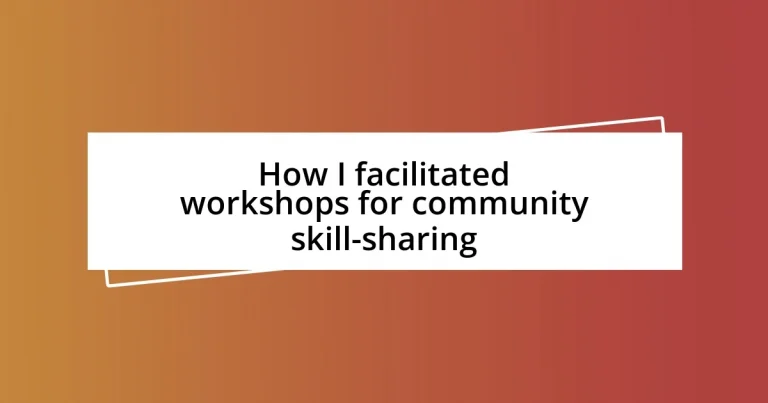Key takeaways:
- Community skill-sharing fosters connection, trust, and personal empowerment through sharing unique abilities.
- Identifying community needs via discussions and surveys enhances the relevance and engagement of workshops.
- Sustaining participant engagement through follow-ups and online spaces encourages ongoing learning and fosters a sense of belonging.
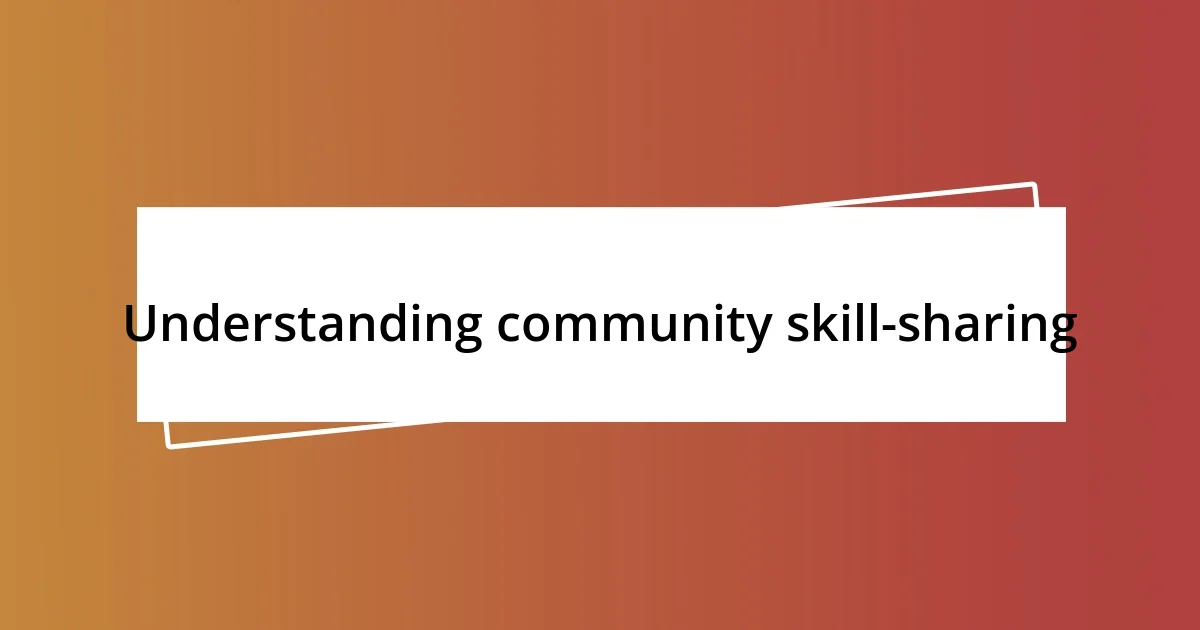
Understanding community skill-sharing
When I first encountered the concept of community skill-sharing, it felt like a breath of fresh air. I remember attending a workshop where someone shared their passion for sewing, and suddenly, a group of strangers transformed into a close-knit community, all inspired by a simple skill. Isn’t it amazing how sharing something as basic as stitching can connect us on a personal level?
Skill-sharing goes beyond just exchanging knowledge; it builds trust and creates an environment where people feel valued. The first time I facilitated a session, I noticed how participants were eager to share not only their skills but also their stories. It was touching to see how teaching a craft could empower individuals and foster lifelong friendships—how often do we get a chance to bond over our unique abilities?
It’s fascinating to think about the hidden talents that lie within our communities. Have you ever wondered what skills your neighbor possesses that could enrich your life? Personally, I’ve learned everything from gardening techniques to digital marketing strategies through community workshops. Each session reminds me that everyone has something meaningful to contribute, making it essential to embrace and nurture this culture of sharing.
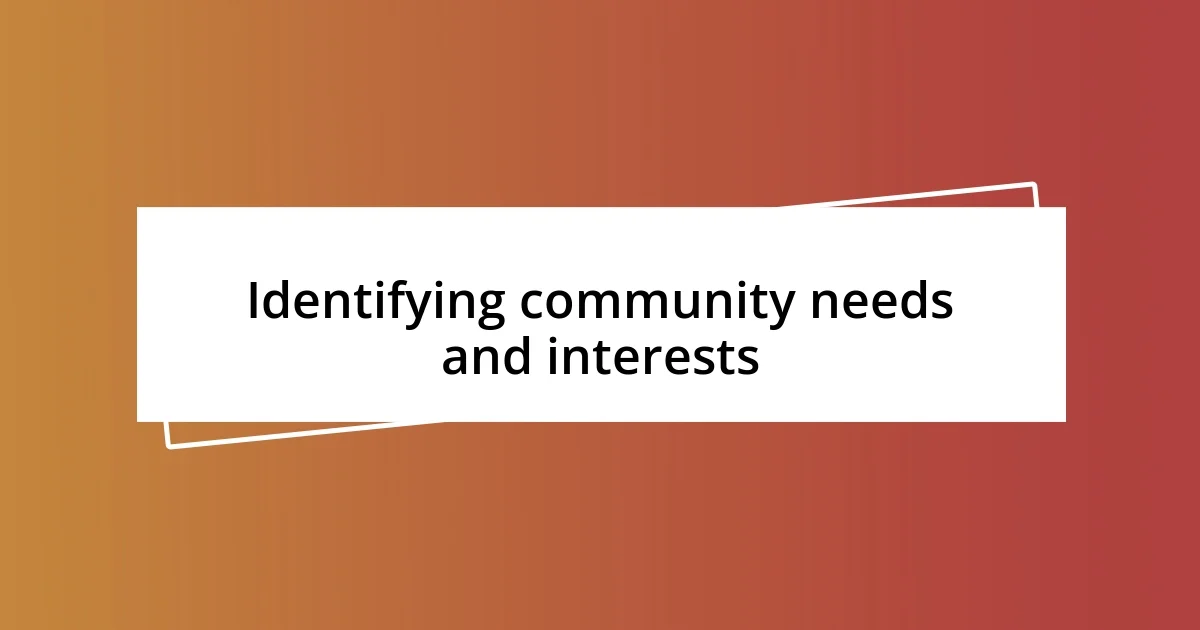
Identifying community needs and interests
Identifying community needs and interests is an essential step in facilitating effective skill-sharing workshops. During one of my early experiences, I led a casual gathering at a local community center. I created an open space for attendees to voice their thoughts on what skills they wanted to learn or teach. This not only encouraged participation but also revealed surprising interests, like a passion for cooking traditional family recipes that I didn’t know existed in our neighborhood.
I realized that establishing connections through conversation is key to uncovering community needs. One particular story stands out: while speaking to a group of attendees, I discovered that several people were keen to learn about sustainable living practices. This insight led us to organize sessions specifically focused on permaculture and zero-waste lifestyles. It’s incredible how actively listening to community voices can transform the direction of workshops and make them directly relevant to participants.
Creating a simple survey can also be instrumental in identifying these needs. I’ve found that informal checklists or even talking to neighbors over coffee can yield a wealth of information. By gathering feedback, not only do we ensure that the workshops are engaging, but we also empower community members to take ownership of their learning journey. After all, when we understand what truly resonates with people, we set the stage for meaningful skill-sharing experiences.
| Method | Description |
|---|---|
| Group Discussions | Encourage open dialogue to reveal interests and needs. |
| Surveys | Utilize informal checklists to gather community preferences. |
| One-on-One Conversations | Engage individually to uncover hidden skills and desires. |
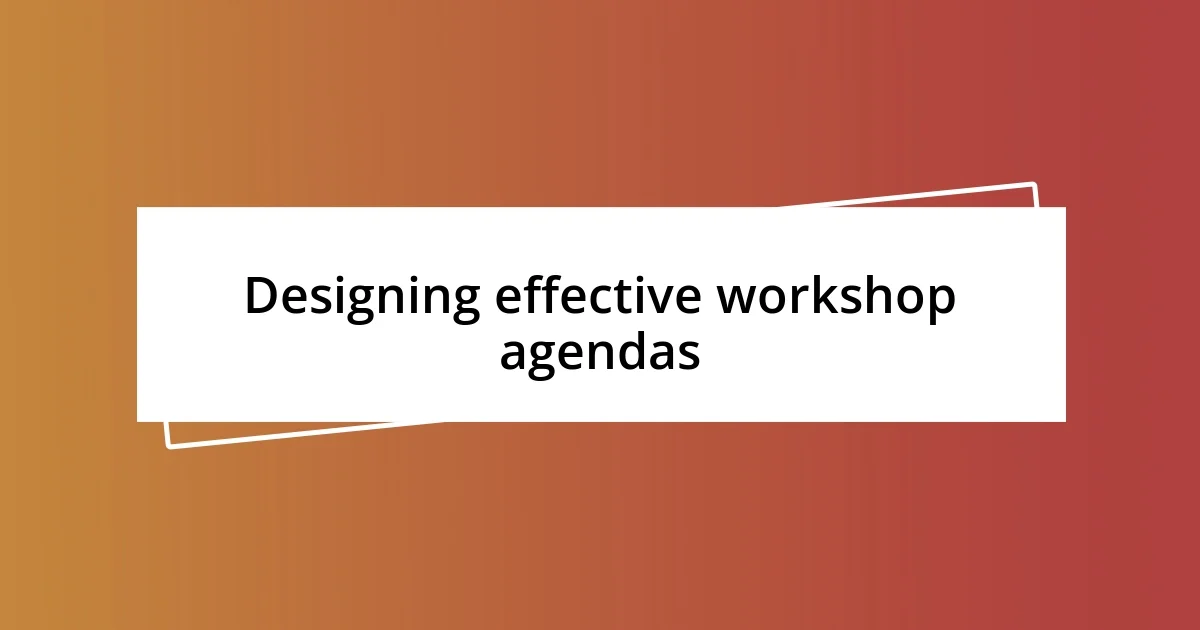
Designing effective workshop agendas
Crafting an effective workshop agenda is like designing a roadmap for success. I always start with a clear objective in mind, ensuring each segment of the agenda contributes specifically to that goal. Once, while planning a photography workshop, I dedicated the first segment to understanding participants’ expectations, which helped establish a shared vision. This connection fueled enthusiasm, making everyone feel invested in the session.
When I outline the agenda, I keep a flexible flow in mind. Sharing the structure of the workshop with participants not only fosters transparency but also allows for their input. Here are key components I’ve learned to prioritize:
- Icebreakers: They set a relaxed tone and encourage engagement right from the start.
- Skill Demonstrations: A focused segment where an expert showcases techniques provides guidance and inspiration.
- Hands-on Practice: Allowing attendees to apply what they’ve learned solidifies their understanding in real-time.
- Feedback Loops: Short sessions for participants to reflect can keep the energy high and reinforce their learning.
- Wrap-Up: Summarizing key takeaways helps anchor the knowledge and allows for a smooth transition into future skills-sharing opportunities.
In my experience, balancing time for sharing stories or personal insights can transform the atmosphere. I recall a workshop where an unexpected conversation about overcoming fear in public speaking turned out to be a highlight, sparking vulnerability and connection among the attendees. It reminded me that workshops are not just about skills; they are spaces for building trust and collaboration.
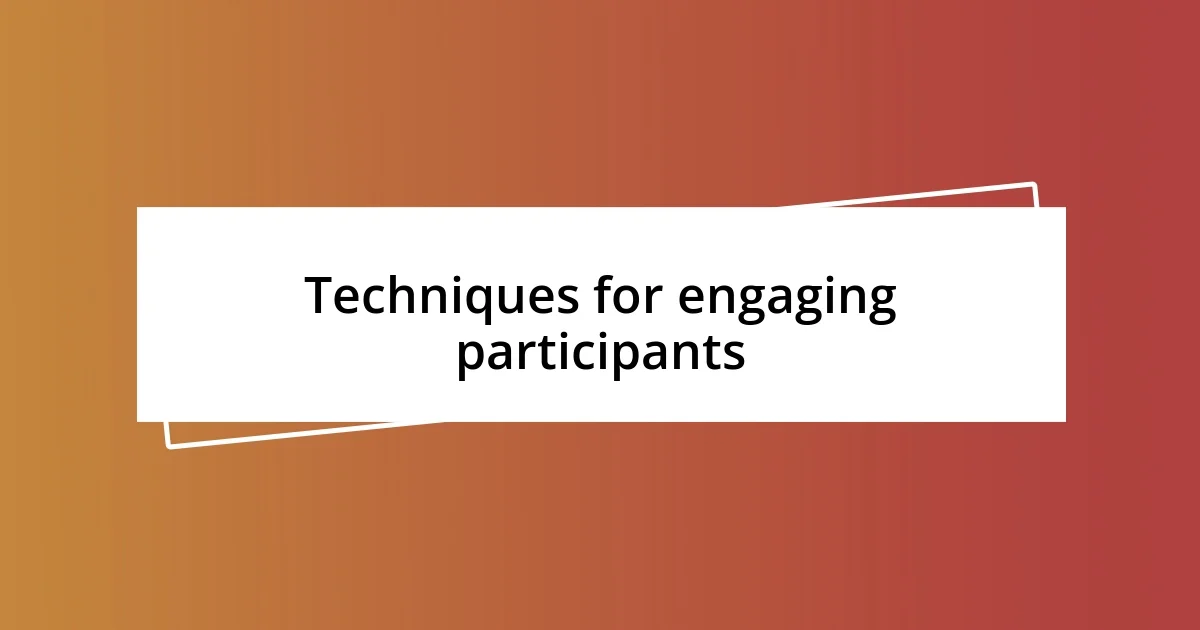
Techniques for engaging participants
Engaging participants in workshops goes beyond just presenting information; it’s about creating an environment where everyone feels valued and motivated to contribute. I’ve found that incorporating interactive activities significantly enhances engagement. For instance, during a community gardening workshop, I divided participants into small groups to brainstorm what plants they’d like to grow. This not only sparked excitement but allowed each voice to be heard, cultivating a sense of ownership over the garden project. Have you ever noticed how ideas can flourish in collaborative atmospheres?
Another technique that has proven effective is using storytelling. When I shared my personal journey of learning to bake bread from scratch, attendees not only connected with me on a personal level but also shared their own experiences. It transformed our session into a rich tapestry of stories and knowledge, invigorating the collective energy. Participants often recall those moments far longer than any technical lesson. What is it about personal stories that captivates us so deeply?
Lastly, incorporating gamified elements into your workshops can elevate participation levels significantly. I remember a skill-sharing event where we turned a challenge of crafting household items from recycled materials into a friendly competition. The laughter and creativity that emerged were infectious, creating an engaging and vibrant atmosphere. Participants were not just observers; they became active creators in the experience. Have you thought about how a little playfulness could redefine your approach to skill-sharing?
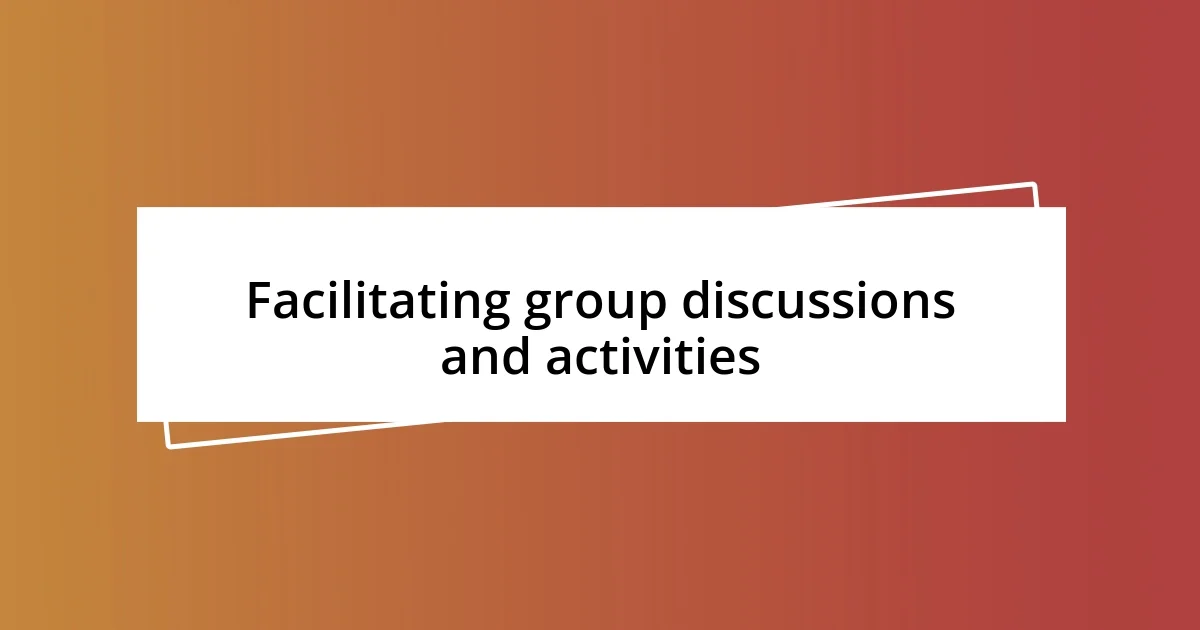
Facilitating group discussions and activities
Facilitating group discussions and activities requires a delicate balance of guidance and freedom. I remember a time when I organized a workshop on digital storytelling. I kicked off the discussion by asking each participant to share their favorite story format. The variety surprised everyone and sparked debates, leading to an organic flow of ideas. Have you ever noticed how a simple question can ignite a passionate conversation among a group?
Encouraging participants to take ownership during discussions is crucial. During a recent skill exchange on painting techniques, I divided the attendees into pairs to share their unique styles. Watching them collaborate and critique one another was a joy—each person lit up as they recognized the value of their perspective. It made me reflect on how often we undervalue our own experiences; isn’t it fascinating how sharing can validate our contributions?
Incorporating activities that prompt movement can also liven up discussions. I once facilitated a workshop where participants engaged in a “gallery walk” to display their art. As attendees moved around, they exchanged thoughts and feedback on each piece, creating an uplifting atmosphere filled with joy and encouragement. Isn’t it amazing how physical movement can energize a conversation and foster deeper connections? By breaking the traditional seated format, I noticed that creativity flowed more freely, allowing us all to experience the workshop in a new light.
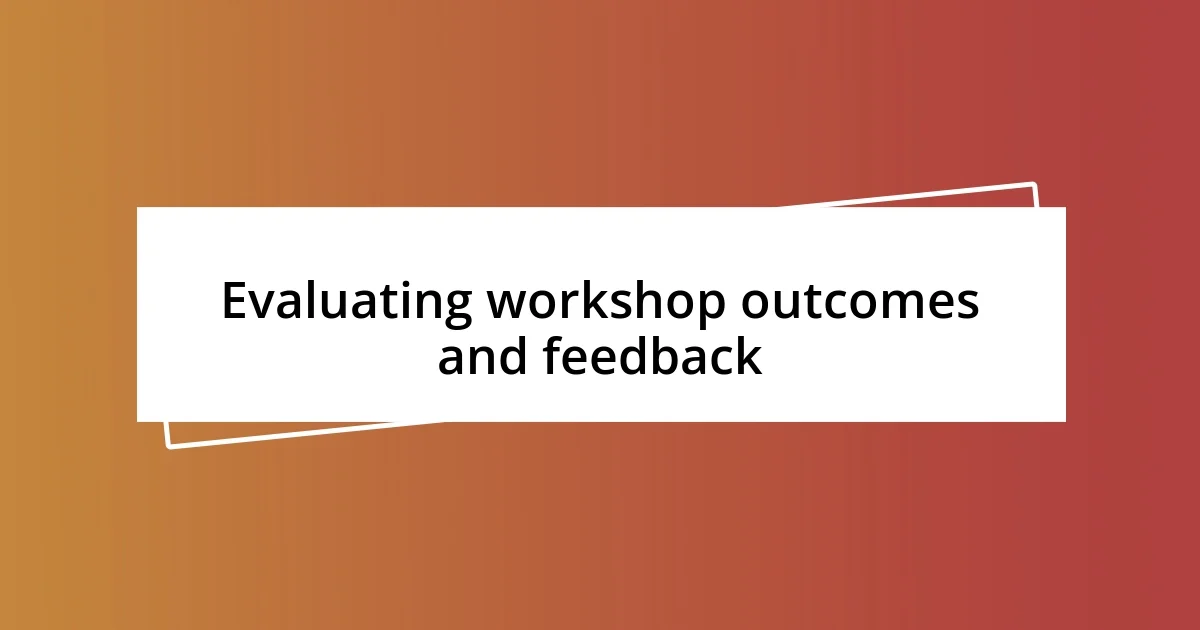
Evaluating workshop outcomes and feedback
Evaluating the outcomes of my workshops is a fulfilling process that offers me valuable insights into their impact. After each session, I like to send out feedback forms, which often reveal unexpected gems. One time, a participant shared how the workshop not only taught them a new skill but also inspired them to start a community project. Isn’t it incredible how something as simple as a few hours of sharing can ignite such passion?
Conversations during follow-up sessions can be equally enlightening. I often ask participants to reflect on what they learned and how they plan to apply their newfound skills. During a recent workshop on homemade cosmetic products, one attendee expressed that they felt empowered to advocate for sustainability in her social circle. This feedback reinforces the idea that skill-sharing can act as a catalyst for broader community change, doesn’t it?
Lastly, I find that creating a safe space for open dialogue about the workshop outcomes allows me to refine future sessions. In one workshop on digital literacy, someone mentioned they felt overwhelmed by the pace. Listening to such feedback encouraged me to adjust my teaching methods, ensuring I cater to varying learning speeds. Isn’t it fascinating how just a tweak in approach can significantly enhance the learning experience for everyone involved?
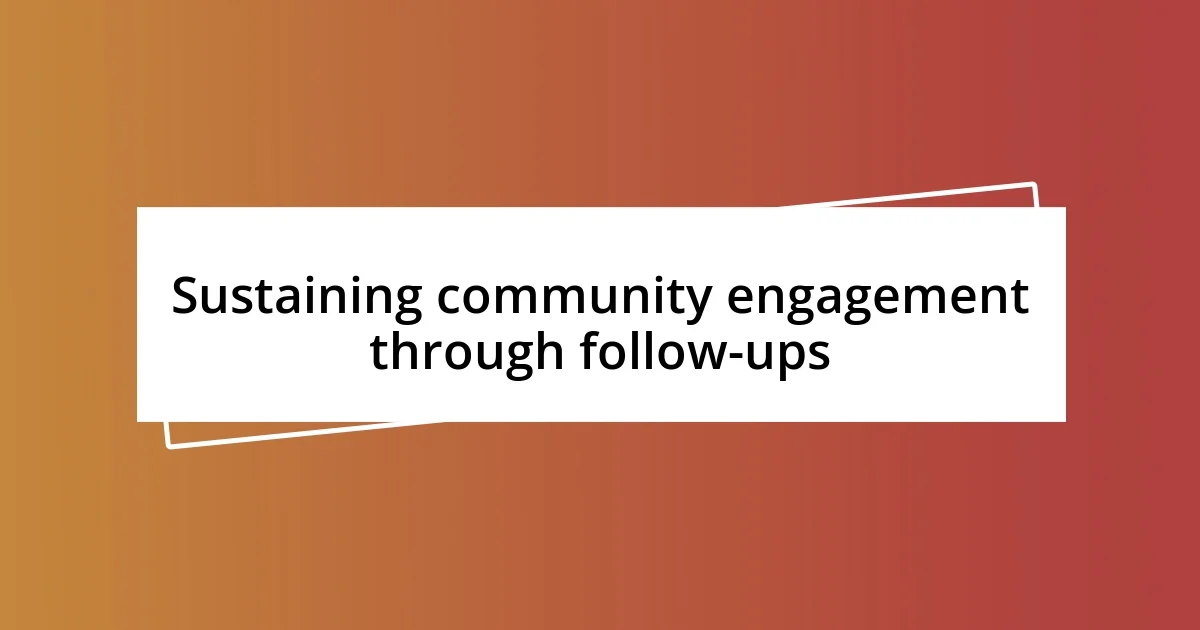
Sustaining community engagement through follow-ups
Sustaining engagement after workshops is crucial, and my approach involves regular follow-ups that make participants feel valued. For example, a month after a cooking workshop, I sent out recipe booklet PDFs along with a personal note from me reflecting on our time together. It was heartwarming to hear back from many participants expressing excitement about trying new dishes and sharing their successes with their families. Isn’t it wonderful how a little thoughtfulness can keep the fire of enthusiasm burning?
I also host monthly check-ins where participants can discuss their progress or challenges. I vividly recall when someone from a recent photography workshop shared her journey of launching an Instagram page dedicated to her artistic photography. The community cheered her on during our virtual meeting, creating an uplifting atmosphere that encouraged others to share their stories, too. This sense of belonging is vital; doesn’t nurturing these connections enhance not just individual growth but the community as a whole?
Additionally, I curate an online space where participants can share their projects and seek feedback. One participant turned a simple idea from my craft workshop into a local project, inviting others to contribute their skills. Watching that project flourish into a community event was unexpected but profoundly gratifying. How often do we miss opportunities for deeper connections simply because we don’t keep the conversation alive? Building on those moments helps sustain the momentum of our workshops long after they end.












